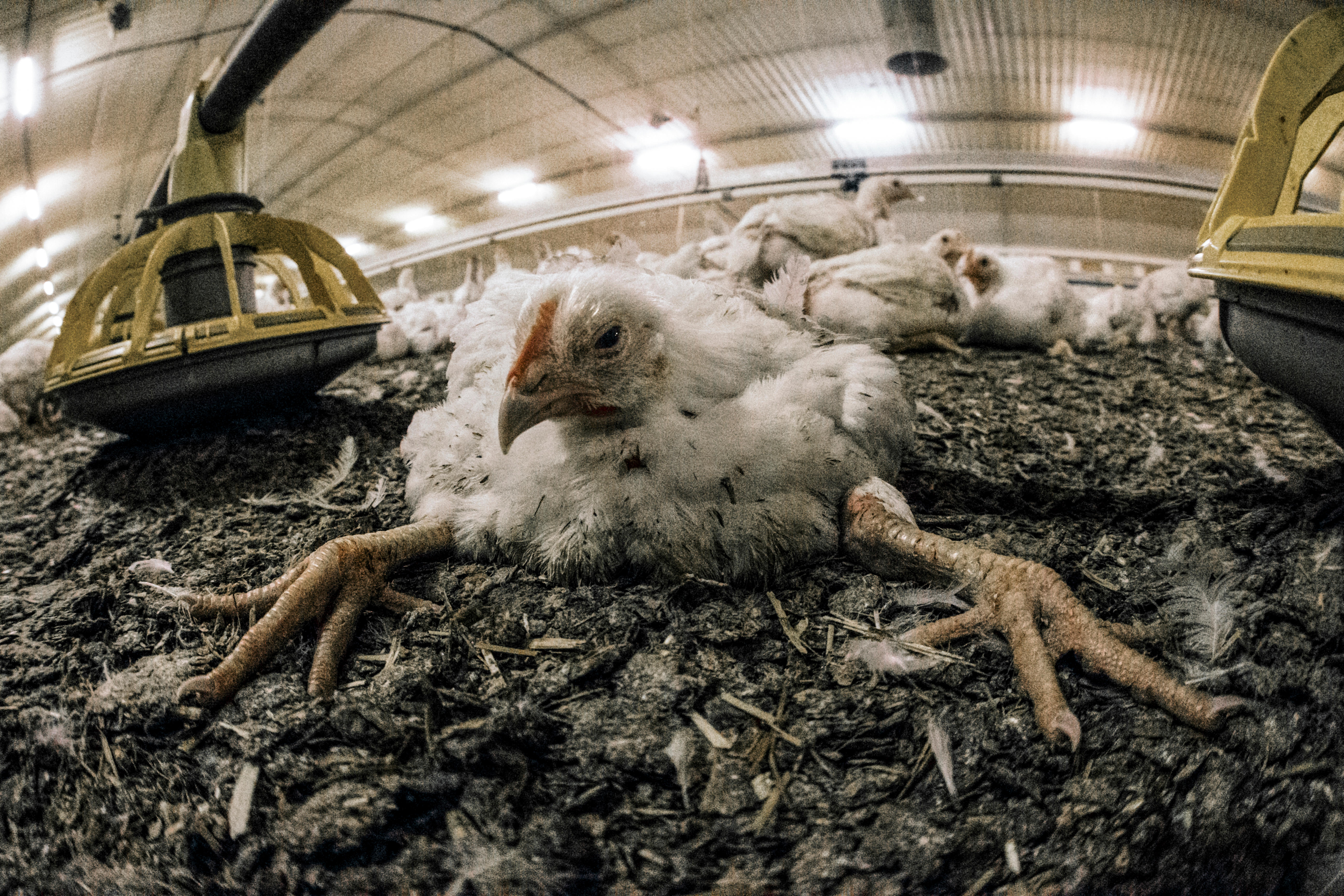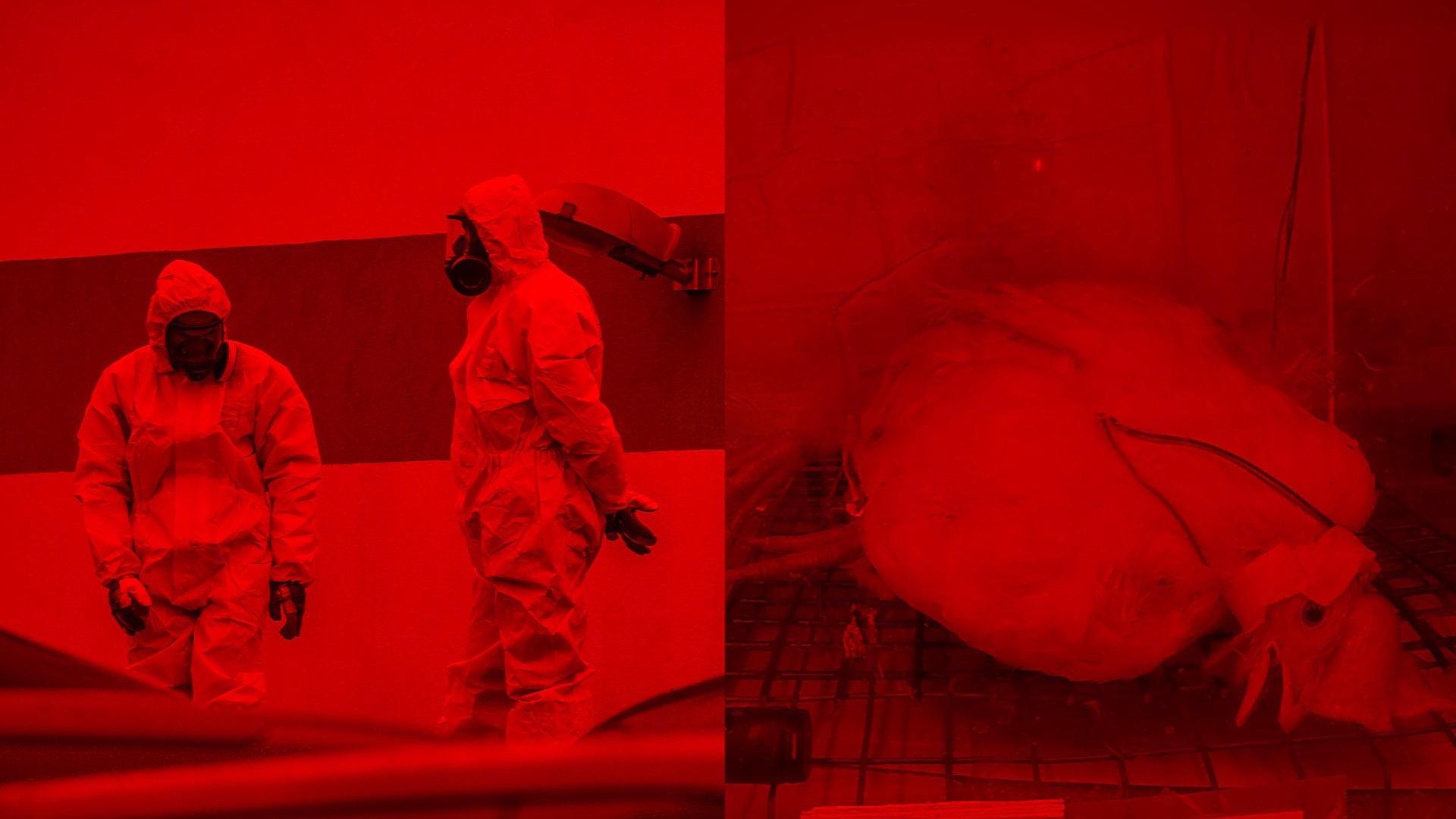




Avian influenza is devastating both wild and domestic bird populations, another symptom of a broken food system.

A deadly bird flu has been making its way across the globe since 2020, leaving millions of farmed poultry and an incalculable number of wild birds dead in its wake. This is not the first outbreak of bird flu, or highly pathogenic avian influenza (HPAI), but it is different. It’s worse.
This outbreak is "wiping out everything in numbers that we've never seen before," according to Jennifer Mullinax, a researcher at the University of Maryland who co-authored a recent study on this latest strain for the journal Conservation Biology.
It's not only affecting birds either. The virus has been detected in mammals such as foxes, seals, dolphins, bears, mountain lions, domestic pets, and even a small number of humans. While the risk to humans is currently considered low, it's not negligible. The influenza pandemic of 1918, which infected roughly one-third of the world's population, was caused by a virus with avian origins. And as we continue to adapt and reshape our world around COVID-19—a viral disease that most likely originated in animal populations—the dangers associated with HPAI are not to be ignored.
I think Natasha Spottiswoode, an infectious disease fellow at UC San Francisco, explained it best when she said that the risk posed by bird flu is akin to that of an avalanche.
"Pandemics are a bit like avalanches—they are both individually low probability, but extremely high consequence events... You can ski the same slope every year and nothing will happen. It becomes tempting to say, 'I'll go out today without safety equipment.' Then, one day, everything just comes down on you."
If HPAI is the next potential avalanche, then industrialized chicken farming is a heavy metal rock band performing at the bottom of the mountain, sending booming sound waves, one after another, up toward its steep slope.
It's time to unplug the band's amplifiers, before they set off a disaster. It's time to address the sordid conditions of industrial poultry and egg farms.
Life on factory farms
It's an understatement to say the vast majority of chicken meat and eggs consumed in the United States comes from factory farms. In fact, less than 1% of all chickens raised for meat (so-called "broiler chickens") don't live in these massive, mechanized environments. Thanks to recent cage-free campaigns, more and more chickens raised for eggs (layer hens) have been given more space and better conditions. However, more than half—around 60%—are still confined in cages.
The life of a factory farmed broiler chicken is not long. Because of rapid growth due to selective breeding, chickens reach market weight within about 40 days of hatching. They live in massive, windowless, crowded sheds—a single structure may house as many as 50,000 birds.
Per industry standards, chickens can be given as little as 100 square inches to themselves. That's not enough space to walk, peck, or preen. It's not even enough space to spread their wings.
Even if they had the space to engage in their natural behaviors, they likely couldn't. Due to years of selective breeding, chickens today grow more than twice as large in less than half the time, than they did in the 1950s. These unnaturally large birds suffer muscle myopathies, leg deformities, poor foot health, and have trouble simply standing or walking.
Egg-laying hens also face harsh conditions. Their suffering begins a few days after hatching, when a machine with a hot blade might slice off part of the chick's beak. The process of "beak-trimming" or "debeaking"—banned in some parts of the world—is cruel and painful, particularly when hot blades are used. Routine hot-blade beak trimming is banned in the EU and UK, and where beak trimming is permitted, it must be done using infra-red technology when the chick is a day old. Beak trimming reduces the impact of injurious pecking behaviors which can lead to cannibalism—that chickens sometimes engage in due to a wide range of factors, including nutritional deficiencies, lack of foraging opportunities, genetics, living conditions, lighting, and so on. There are many different types of feather pecking that can occur within flocks, such as injurious pecking or aggressive pecking. These can occur within all flocks, but the use of beak trimming is related to injurious pecking which is an abnormal behavior. Injurious feather pecking can occur within flocks both large and small, it can also occur in all types of farming systems, including in free-range and organic systems.
From there, most layer hens are tightly packed inside of barren, cramped "battery cages", which have been banned in the European Union, but not in the US. These cages attempt to cram as many animals into the space as possible, thereby increasing production. Hens can generally stand within these barren cages, but the low height may not enable them to fully stand or stretch out.
Industrial-sized egg farms use selective breeding, lighting manipulation, and forced molting (a process that deprives the animals of food and water) to keep hens laying eggs at far greater rates than they would in natural conditions. Ancestral chickens, such as the Red Jungle Fowl, laid just 10-12 eggs in a year. On today's factory farms, by contrast, hens are expected to lay as many as 300 in that time. Commercial laying hens have been selectively bred to lay high volumes of eggs, and forced molting may be used to extend the laying cycle.
A public health issue
Now, if I were a chicken confined to live out my life on a factory farm, crowded together with thousands of other birds, suffering chronic physical pain, forced through various methods to develop or lay eggs at disturbingly unnatural rates, I know one thing, I would be more than a little stressed.
It's broadly accepted that elevated stress levels weaken poultry's immune systems and saps their ability to ward off diseases. Just like humans.
And when there's a deadly virus rapidly spreading through bird populations, just about the last thing I'd want to do is tightly pack tens of thousands of these overly stressed, overly taxed birds into the same cramped, little space.
But it gets worse. Not only are factory farms providing the perfectly vulnerable populations through which HPAI can spread. Massive agricultural operations—poultry farms and others—are fueling climate change and deforestation. As the world gets hotter and exotic species natural habitats get destroyed, wild animals species are fleeing the equator for the poles. This mass migration makes it more likely for once remote animal species to come into contact with other wild animals, livestock, humans, making it more likely for viruses to spread among species, and making the next pandemic far more likely.
Michael Greger, an American physician who wrote the book Bird Flu: A Virus of Our Own Hatching in 2006, put it succinctly when he said,"if you actually want to create global pandemics, then build factory farms."
"When we overcrowd animals by the thousands, in cramped football-field-size sheds, to lie beak to beak or snout to snout, and there's stress crippling their immune systems, and there's ammonia from the decomposing waste burning their lungs, and there's a lack of fresh air and sunlight—put all these factors together and you have a perfect-storm environment for the emergence and spread of disease," Greger told Vox in 2020.
In a June 2023 episode of the podcast "This Week in Virology," a group of public health experts discussed HPAI, and wondered aloud why this current outbreak is so much worse than past outbreaks. Angela Mingarelli, a veterinarian and PhD candidate, offered a thought.
"If we think about 100 years ago, intensive farming looked nothing like it does today," she said. "The more we intensively farm animals, and we crowd them altogether in these very, very small enclosures, sometimes with poor ventilation, and these animals can be severely immunocompromised because they have poor diets... if they were to be confronted with [a] virus, then they would be more susceptible, potentially, to getting sick."
It's not just individual experts who are pointing out the dangerous links between factory farming and the spread of disease. In an August 2023 report, Compassion in World Farming made a plea to the agricultural industry to make major reforms as an essential step in curbing the rate of bird flu's spread.
"It is critical that the poultry sector adopts smaller flocks, lower stocking densities and more robust breeds with higher levels of natural immunity. This will reduce the risk of highly pathogenic bird flu strains emerging and spreading," reads the report, which also advises the government to consider offering financial support to farms willing to adapt, close down or relocate to less farm-dense areas.
The previous month, a UN-led scientific task force on avian influenza also published a report sounding the alarm that HPAI is a global issue, and it's going to take a coordinated, global response to slow the spread.
As a minimum, the task force said, "a reduction in density of production facilities is needed along with factoring disease risk into land planning for poultry rearing activities which can help to anticipate and reduce the conditions that allow for the mixing of wild and domestic species."
What can be done?
Reforming agriculture can take place at both the government and corporate levels. In this critical time, we should be putting pressure on both.
As a first step, chickens should not be kept in cages. It's not just cruel and inhumane. It's exactly the kind of densely packed living conditions that can allow viruses to spread.
A handful of states have already outlawed confining hens into battery cages, but it remains an industry standard throughout much of the US. In one fell swoop, federal legislation could make these cages a thing of the past nationwide. Unfortunately, past efforts to pass such bans have been undermined by industry lobbying. And as Congress, at the time of this writing, is currently poring through heaps of bills and proposals that will come together to form the 2023 Farm Bill, meat and dairy lobbyists are pushing for dangerous legislation that would decimate, not strengthen, animal protections.
In recent years, there have been some more promising developments from the corporate side. Food companies respond to consumer demands, and as consumers are becoming more and more concerned about where their meals originate, even some major powerhouses have listened.
In 2016, animal activists successfully got Walmart—the world's largest company by revenue—to commit to going cage-free for the 35 million layer hens in its supply chain. The store has been followed by other retail giants like CVS and Walgreens—both of which accelerated their commitments and went 100% cage-free in 2022.
Activists have also scored victories with the country's leading restaurant chains, more than 2,000 of which—including Burger King, Chipotle, Starbucks, and Taco Bell—have made public promises to go completely cage-free. While these promises represent progress worth celebrating, animal rights groups are keeping a close eye on these companies' progress, and putting extra pressure on any that fall behind on their commitment.
The Better Chicken Commitment (BCC) is another positive movement really picking up steam. Agreed to by more than 200 companies so far, the commitment essentially requires chickens to be reared in quarters that are more spacious, enriching, and, in general, healthy. The BCC also requires the use of higher-welfare breeds, which have stronger immunity.
These first steps alone are not going to mitigate the threats posed by avian influenza. However, they are important starting points. Once we look deeper into the "how" and "where" of our foods, we start to see the delicate interconnectedness between all of Earth's inhabitants.
The risks posed by bird flu are an urgent signal that it's time to reevaluate food systems. For the health of animals, the planet, and ourselves.





